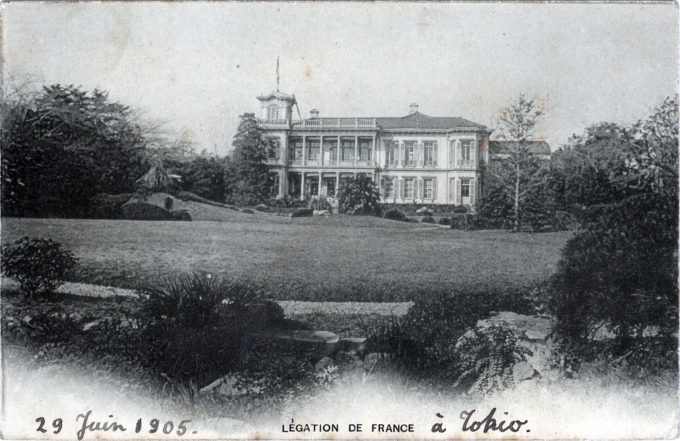“After nearly two centuries of sakoku [self-imposed seclusion] ordered by the Tokugawara shogunate, Japan formed a strong bond with France, becoming important partners with it during Japan’s late 19th century modernization in military, economic, legal and artistic fields.
“Ironically, it was the isolationist Tokugawa shogunate who first enlisted the services of a foreign power, modernizing its army through the assistance of French military missions. After the Meiji Restoration, Japan initially relied on France for several aspects of its modernization, particularly the development of a shipbuilding industry during the early years of the Imperial Japanese Navy, and the development of a western-style Legal code.
“In turn, France derived part of its modern artistic inspiration from Japanese art, essentially through Japonism and its influence on Impressionism, and almost completely relied on Japan for its prosperous silk industry.
“The signing in 1907 of the Franco-Japanese Treaty was part of the French coalition-building initiative it undertook at the turn of the century as France took the lead in creating alliances with not only Japan but Russia and (informally) with Britain. Japan wanted to raise a loan in Paris, so France made the loan contingent on a Russo-Japanese agreement and a Japanese guaranty for France’s strategically vulnerable possessions in Indochina.
“Thus was built the Triple Entente coalition (Great Britain, France and Russia, plus Japan’s nominal role) that fought World War I against the Central Powers (Germany and Austria-Hungary).”
– Wikipedia

French Legation, Tokyo, 1905. The first French legation was established in 1858 (and would be raised to ’embassy’ status in 1906) and later took residence at Iidabashi near the Imperial Palace. The building was severely damaged by the Great Kanto Earthquake in 1923, and replaced in 1928 by a new building designed by Antonin Raymond. To the Japanese people of the Meiji Era, French political thought was key to forming the ideal state of politics. In the process of building Japan’s modern legal system, French laws, including the Code Napoléon, served as important models for the emerging Japanese government bureaucracy.
See also:
Yokosuka Naval Arsenal, c. 1910.
Victorious Great Powers at the Paris Peace Conference, 1919.
The Kawakami Theater performing “Okan” at Meiji-za, Tokyo, c. 1905.
Timeline of early Franco-Japanese relations, 1858-1910
1858: The Treaty of Amity and Commerce between France and Japan is signed in Edo on October 9, 1858, by Jean-Baptiste Louis Gros, opening diplomatic relations between the two countries.
1859: Arrival of Gustave Duchesne de Bellecourt.
1862: Shōgun Tokugawa Iemochi sends First Japanese Embassy to Europe, led by Takenouchi Yasunori.
1863: Second Japanese Embassy to Europe
1864: Bombardment of Shimonoseki by allied ships (9 British, 3 French, 4 Dutch, 1 American).
1864: In November Leonce Verny arrives in Japan for the construction of the Yokosuka Naval Arsenal.
1865: Shibata Takenaka visits France to prepare for the construction of the Yokosuka arsenal and organize a French military mission to Japan.
1865: On September 12, 1865, the Messageries Maritimes passenger liner ship Dupleix was the first to call at a Japanese port to start a new service with France, both for passengers as well as for cargoes such as Japanese silk.
1867: The first French Military Mission to Japan arrives in Yokohama January 13, 1867. Among them is Captain Jules Brunet.
1867: Japan sends a delegation to the 1867 World Fair in Paris.
1870: Henri Pelegrin directs the construction of Japan’s first gas-lighting system in the streets of Nihonbashi, Ginza and Yokohama.
1872: Paul Brunat opens the first modern Japanese silk spinning factory at Tomioka. Three craftsmen from the Nishijin weaving district in Kyoto travel to Lyon. They travel back to Japan in 1873, importing a Jacquard loom.
1872: Start of the second French Military Mission to Japan (1872-1880).
1873: The legal expert Gustave Emile Boissonade arrives in Japan to help build a modern legal system.
1874: The Second French Military Mission is sent to Japan, and builds the military school of Ichigaya, the start of the Imperial Japanese Army Academy.
1882: The first tramways are introduced from France and start functioning at Asakusa, and between Shinbashi and Ueno.
1884: Third French Military Mission to Japan (1884-1889).
1886: The French naval engineer Emile Bertin starts a four years’ stay in Japan to advise the government on how to reinforce the Imperial Japanese Navy with new modern ships, and directs the expansion and modernization of the Yokosuka Naval Arsenal and the design and initial construction of the new arsenals of Kure and Sasebo, thereby contributing to the Japanese victory in the Russo-Japanese War in 1905.
1898: The first automobile (a Panhard-Levassor) is introduced in Japan.
1907: Signing of the Franco-Japanese Treaty of 1907. France took the lead in creating alliances with Japan, Russia and (informally) with Britain.
1910: Captain Tokugawa Yoshitoshi, trained in France as a pilot, makes the first self-propelled flight on board a Henri Farman plane.

